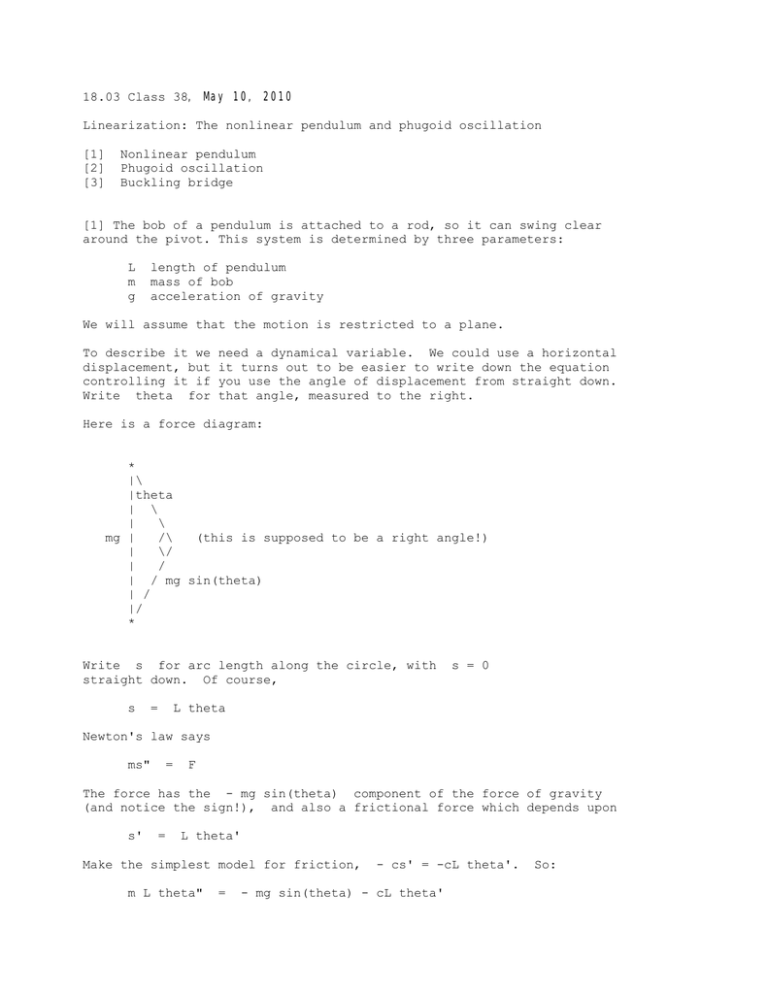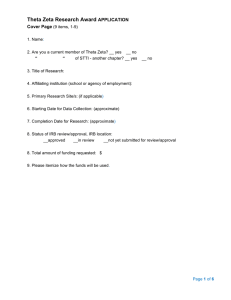, May 10, 2010 18.03 Class 38
advertisement

18.03 Class 38, May 10, 2010 Linearization: The nonlinear pendulum and phugoid oscillation [1] [2] [3] Nonlinear pendulum Phugoid oscillation Buckling bridge [1] The bob of a pendulum is attached to a rod, so it can swing clear around the pivot. This system is determined by three parameters: L m g length of pendulum mass of bob acceleration of gravity We will assume that the motion is restricted to a plane. To describe it we displacement, but controlling it if Write theta for need a dynamical variable. We could use a horizontal it turns out to be easier to write down the equation you use the angle of displacement from straight down. that angle, measured to the right. Here is a force diagram: * |\ |theta | \ | \ mg | /\ (this is supposed to be a right angle!) | \/ | / | / mg sin(theta) | / |/ * Write s for arc length along the circle, with straight down. Of course, s = s = 0 L theta Newton's law says ms" = F The force has the - mg sin(theta) component of the force of gravity (and notice the sign!), and also a frictional force which depends upon s' = L theta' Make the simplest model for friction, m L theta" = - cs' = -cL theta'. - mg sin(theta) - cL theta' So: Divide through by theta" + where k = g/L mL and we get b theta' + k sin(theta) and = 0 b = c/m . This is a nonlinear second order equation. It still has a "companion first order system," obtained by setting x so = theta , y = x' y' = theta" = - k sin(theta) - b theta' x' y' = = or y - k sin(x) - by This is an autonmous system. Let's study its phase portrait. Equilibria: x = y = 0 , sin(x) = 0 ; that is, 0 , +-pi , +-2pi , ... Let's compute the Jacobian: J(x,y) When = [ 0 , 1 ; - k cos(x) , -b ] x = 0 , +-2pi , +-4pi , ...., J(x,y) = [ 0 1 ; -k det = k , tr = -b . Suppose When = [ 0 1 ; k and -b ] b x = +-pi , +-3pi , ..., J(x,y) cos(x) = 1 is small, so we get spirals. cos(x) = -1 and -b ] det = -k , tr = -b : saddles. Then I revealed the entire phase portrait. It shows another feature common to all companion systems: The trajectories above the x axis move right, those below move left. Trajectories coming down from the left represent the pendulum swinging around in counterclockwise complete circles. Trajectories coming up from the right represent the pendulum swinging around in clockwise circles. With a student I animated the pendulum swinging around. The successive dips represent passing through the vertical position. In very exceptional cases, the trajectory heads straight at the saddle equilibria; they converge to it exponentially, but most likely miss and move away from it exponentially. The saddles represent the unstable equilibria which are straight up. Eventually, the trajectory gets caught in a basin (actually it was always in that basin) and spiral in towards the attractor of that basin, which is straight down. [2] Phugoid equation. The forces on an airplane are like this: suppose the plane is moving to the right. It is tipped up a bit, which is hard to draw using ascii. Along the directon of motion we have the thrust, created by the engines Directed downwards we have the force of gravity, AKA the weight of the plane. There is a frictional force, which we decompose into two componets: Drag is directed against the thrust, Lift is directed perpendicularly to the direction of motion. One can analyze the effect of these forces near equilibrium. Write F for the thrust g for the acceleration of gravity m for the mass of the plane v_0 for equilibrium speed. At equilibrium the airplane is moving horizontally. We study what happens when you are jarred off of equilibruium, by a downdraft for example. Then the horizontal component of the velocity is v_0 + u and the vertical component is w , where u and w are small relative to v_0 . d -dt | u | | | | w | = | - 2F/mv_0 | | 2g/v_0 -g/v_0 0 | | u | | | | | | w | The characteristic polynomial is p_A(lambda) = lambda^2 + (2F/mv_0) lambda + (2g^2/v_0^2) Let's use the language of natural frequency and damping ratio: p_A(lambda) = lambda^2 + 2 zeta omega_n lambda + omega_n^2 so omega_n = (sqrt 2) g/v_0 2F / mv_0 = 2 zeta omega_n = 2 zeta (sqrt 2) g / v_0 zeta = (1/sqrt(2)) F/mg Lessons to be learned from this linearization: (1) The period of this "phugoid oscillation" depends *only on the equilibrium speed* and not on the thrust or mass of the airplane. In units of meters and seconds, it comes to about 0.45 v_0 . Boeing 747 : F15 : 260 838 m/sec : m/sec : 118 seconds 380 seconds (2) The damping ratio depends only on *thrust/weight*. thrust/weight are dimensionless, the same in all units. The system is underdamped as long as zeta < 1 , ie Both zeta and F/mg < sqrt(2) Even an F15 doesn't come close to having phugoid system is always underdamped: 747 : F15: F/mg ~ .27 , F/mg ~ .67 , F/mg > sqrt(2) ! - so the zeta ~ .19 zeta ~ .47 [3] I want to show you this movie. In the summer of 1940, a bridge was built ove the Tacoma Narrows in Washington State. It was a mile long and just 39 feet across - an elegant suspension bridge. Very early it acquired the sobriquet "Galloping Gerdie," because it would oscillate vertcially in a very exciting way. The structural engineers studied this and concluded that it wasn't a problem. But in November, the first winter storm picked up. The bridge showed a different behavior now - it wasn't oscillating vertically now, it was twisting. Here's a video http://www.youtube.com/watch?v=P0Fi1VcbpAI What happened here? Resonance? The wind was gusting back and forth at just the natural frequency of the bridge? Nah. What happens is this: Suppose theta the bridge. is the angle off of horizontal, at some point along theta" + b theta' + omega^2 theta = F F depends on the wind velocity, but look: When the edge of the bridge tips up, the torisonal force from the wind changes. So perhaps F looks like F = a(v) theta + c(v) theta' Actually, it turns out that the dominant contribution is from the term, so let's simplify by just dropping the theta term. So: theta' theta" + (b-c(v)) theta' + omega_n^2 theta = 0 Now the characteristic polynomial is s^2 + (b-c(v)) s + omega_n^2 = (s + (b-c(v))/2)^2 + omega_d^2 with roots r = (c(v)-b)/2 +- omega_d (The experiment shows the roots are not real!) It turns out that the shape the graph of c(v) is like a W . For v near zero, c(v) < 0 : the effect increases the damping and causes the bridge to be MORE stable. At some point c(v) = 0, which is still OK. But eventually it equals and then surpasses the damping constant b : then you get effective anti-damping, the real part of the root becomes positive, and we get solutions oscillating under increasing exponentials: disaster! MIT OpenCourseWare http://ocw.mit.edu 18.03 Differential Equations �� Spring 2010 For information about citing these materials or our Terms of Use, visit: http://ocw.mit.edu/terms.





